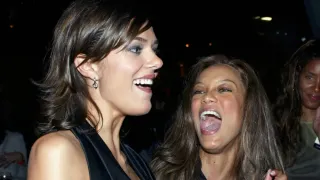
7 hours ago
Freddy Krueger Finds His Forever Home: Robert Englund Gets a Star on Hollywood’s Walk of Fame
READ TIME: 3 MIN.
On Halloween morning, while most of Hollywood was still shaking glitter from last night’s costumes, Robert Englund—the man behind the razor-gloved icon of nightmares—stepped onto 6644 Hollywood Boulevard to claim his place among legends. The date couldn’t have been more perfect: October 31st, 2025, at 11:30 am, with the ghosts of horror’s past and present in attendance, including emcee Steve Nissen, filmmaker Eli Roth, and Heather Langenkamp, who famously squared off against Freddy in the original “A Nightmare on Elm Street” .
Englund’s star, the 2,826th to glitter along the boulevard, marks not just a personal achievement but a moment for horror fans—especially those in the LGBTQ+ community who have always seen themselves in the genre’s misfits, monsters, and final girls .
For decades, horror has been a safe (if blood-soaked) space for queer folks—where coded villains, defiant survivors, and twisted dreamscapes reflect lives lived on society’s edge. Freddy Krueger, with his flamboyant gestures, razor wit, and penchant for dramatic entrances, is nothing if not a drag queen’s fever dream: equal parts menace and camp, with a fashion sense that’s pure statement .
Englund himself has always leaned into the theatricality of the role. “Woke up this morning to discover I’m in great company in the Hollywood Walk of Fame class of 2025,” he tweeted last year, acknowledging his place among horror greats like Boris Karloff, Lon Chaney, and Bela Lugosi—many of whom have long been embraced by LGBTQ+ fans for their outsider status and tragic glamour .
Why do so many queer audiences flock to horror and, specifically, to characters like Freddy? It’s about more than a love of spectacle or a taste for the macabre. Horror has often offered a mirror for those who feel different, with monsters standing in for all manner of “otherness.” Freddy, with his burned visage and midnight monologues, is both feared and fabulous—a monster who refuses to be ignored or erased.
The Hollywood Walk of Fame, with its own queer history—think Judy Garland, Divine, and John Waters—now welcomes Englund to its constellation. His star isn’t just for a man in a mask; it’s for every outsider who found power in their difference. The ceremony’s Halloween timing was almost poetic, with fans arriving in costume, some in full Freddy drag, others as horror’s many final girls. The crowd was as diverse as the genre itself, a testament to horror’s enduring, inclusive appeal .
It’s impossible to talk about Englund’s impact without acknowledging the broader trend of horror as queer canon. From the coded queerness of early Universal monsters to today’s openly LGBTQ+ creators and characters, horror has been a playground for gender and identity exploration. Englund’s Freddy is part of that lineage—a villain who, in his excess, becomes strangely empowering.
As filmmaker Eli Roth said at the ceremony, “Robert Englund didn’t just play a monster—he made Freddy Krueger an icon, someone you root for even as you’re screaming. That’s queer energy, right there”
For LGBTQ+ fans, Englund’s recognition is a reminder: sometimes the monsters are the ones who make the biggest mark, and the Walk of Fame is richer for it.
Englund’s star now sits alongside those of horror’s past, affirming that genre outsiders can become cultural royalty. In a world where queer stories are still too often marginalized, the celebration of a horror icon on the industry’s most visible stage is a victory for difference, resilience, and a touch of the theatrical.
As the ceremony wrapped, Englund grinned, his voice carrying over the crowd: “I’ll be haunting this street for a long time.” For every queer kid who ever found solace in the shadows, that’s a promise worth celebrating .






